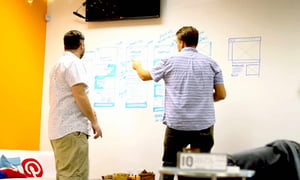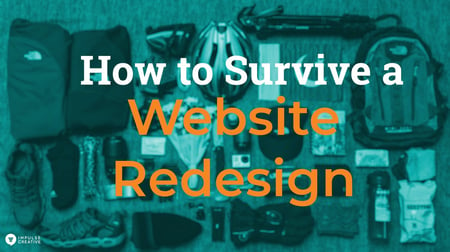The thought of a website redesign may drum up feelings of anxiety, sweaty palms & an increased heart rate, images of 404 errors, and memories of deadlines missed. Frankly, you may be thinking, “Heck no, not ever again!”
But here’s the thing: It doesn’t have to suck.
Sure, you as the business (the owner, the marketer, the marketing team) will have to put some work into it. But it shouldn’t be all you.
A website redesign done by professionals will be collaborative. But it won’t be completely hands-off for you.
In the modern digital era, websites should never again be static things you set and forget. Iteration, tweaks, optimization… it should all apply to your website so it feels more like a living thing.
Minor, continuous adjustments win over huge redesigns in the short term and long term both.

Sometimes you’ll need a complete overhaul. Maybe you haven’t updated your site since 2010. Or perhaps you’ve gone through some changes in the last few years and products or services have changed. In those cases, and others, you may be facing a larger project with new wireframes, a new sitemap, and a fresh design.
Other times, you’re looking at minor changes for conversion optimization.
👉👉 Why We Don’t Always Suggest a Website Redesign 👈👈
So… what happens when you need some level of a site refresh? How do you survive that website redesign?
First, know what you’re getting into. Communication, especially candor, is critical. A lot of businesses feel burned by previous experience with marketing and branding agencies who make it sound like it'll be hands off when in reality it's a collaborative process.
When you’re planning that website redesign, plan on meetings with your agency, plan to bring them your goals and objectives, plan on time giving them content or giving them access and permission to your files and content, and plan on availability for answering questions.
Communication is key.
At Impulse Creative, we’ll do the heavy lifting with our clients, but it takes more collaboration than some businesses may think.
Your Website Redesign Survival Plan
 Step 1: Set aside time for brainstorming and discovery meetings. This could be a couple 1-hour sessions, or it might be a half-day work session. The team working on your website redesign will want to get to know you, the team, and the business in order to best understand the objectives and goals. This will help direct them to the best solutions for the new design of your site.
Step 1: Set aside time for brainstorming and discovery meetings. This could be a couple 1-hour sessions, or it might be a half-day work session. The team working on your website redesign will want to get to know you, the team, and the business in order to best understand the objectives and goals. This will help direct them to the best solutions for the new design of your site.
Each meeting should have a point and an agenda, including brainstorming sessions. You’re not having meetings just to fill time and build up billed hours. You’re having meetings to get sh!t done. But the fact is, meetings will be necessary.
Step 2: Dedicate a team member for communication. Having a point person who knows most of the answers or who can get them quickly will help funnel communication more efficiently. Rather than have everyone messaging everyone else, losing communications in the process, you can rely on a project manager type person to help facilitate the communications.
Tools for this may also include Slack, Flock, email, Zoom, and others. Find what works best for your team and the agency you’re working with (we rely a lot on Slack) and run with it. But always keep one person on your team running point, ready to follow up when needed.
Step 3: Make time for gathering assets. This could be links to your offers/landing pages, blog article archives, sales collateral content, other copy, or any asset your agency may need for the new website. Maybe they’re creating most of it from scratch, but they should also want to know what else you have on-hand. This is especially critical to ensure links aren’t broken in the process, and 301 redirects are in place.
Step 4: Prepare yourself and your team to be ready to consider keeping some elements. In other words, don't throw everything away. Just because you're embarking on a website redesign doesn't mean you have to start from scratch. In addition to finding other sites you "like", you should identify parts of your existing website you'd hate to lose. it can be anything from colors to the content on your Team page - provided you have one. Plus keeping a few familiar elements will help keep return visitors oriented when navigating your new website. Good user experience is about familiarity.
Remember, this process should be collaborative. An agency will likely bring a few roles to the table i.e. design, marketing, writing - you should too. Having different perspectives from your team will help discover and prioritize goals of a new website one person alone might not be able to. Be cognizant of peoples' time however, as everyone may not be required for every meeting. An initial discovery meeting is a good one to invite a few team members too, as well as a final presentation type meeting.
Survival kit photo by Muhammad Masood on Unsplash





